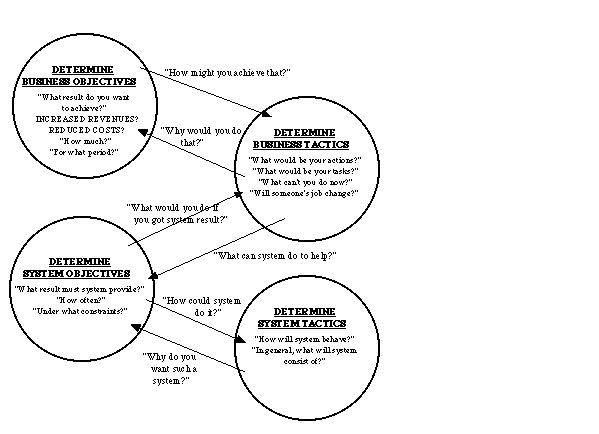
for
MBAC 6080
Kenneth A. Kozar
Spring, 1998
IS Issues - What IS Managers Think?
CSC Index '95 Issues
Beyond Computing '95 Issues
Classic IS/Enterprise Link
"Bill, the bosses upstairs want a realtime online personnel information system. Run up there and get some details while I get the staff coding or we'll never make the deadline they have set for us."
What are areas of concern?
Assumptions About Systems
Bus./IS - What's Important?
"more valid and comprehensive information with a high degree of accuracy and much quicker response"
Can you manage this? Measurements?
Putting It all Together

BUSINESS OBJECTIVES
Classic Costs
Include overtime, waste/spoilage, losing discounts, cash flow loan charges, turnover, absenteeism, fines, space charges, lawsuits, uncollected debts, rework
Classic Revenues
include new markets, repeat customers, new products, product returns, inventory outages, "dunning" improperly, alliances, quick funds recovery, etc.
Searching for Clues
Changes in product line, product quality, product characteristics, markets, price, customers, market position, market share, company size, ROI, profitability, dividends, leadership, .........
BUSINESS TACTICS
Changed Tactics could mean: Business process reengineering, changed job descriptions, changed job entry qualifications, changed compensation, changed training, changed union contracts
SYSTEM OBJECTIVES
What Information?
info about suppliers, customers, government, political influences, competitors, economics
Specifying System Objectives
SYSTEM TACTICS
Link Between Data Flow and Requirements Model?
Gumption Traps
Why Try?
Does this technique apply to Amazon?
Amazon.com has no storefront and little inventory. Online forms allow web ordering with use of encryption or the phone for credit card transmission. Ordered books come from a publisher or distributor and go to Seattle where orders are packed and shipped to reach the customer in a order to receipt time of five days. Paying extra means faster receipt.
All books are discounted 10-30%. Orders are growing about 34% a month and 44% of the customers are repeats. Customers can be notified if they like when their chosen authors have a new book.
Communities of interest can create websites to share information with others who share their interest. Amazon.com will pay your community of interest a 3-8% commission if they link to Amazon.com through your website. Amazon.com has over 1800 of these associates.
The biggest bugaboo in the publishing business is return books. The industry overall average is 30% returns but Amazon.com has a return rate of .25% due their selling practices. Plus, other bookstores have no idea who they are selling to and what a customer profile looks like.
For more on Amazon.com, see their website or an article by Michael H. Martin in Fortune, December 9, 1996, pages 169-170 where much of the above information was gathered.
NEWS FROM EDUPAGE, JANUARY 28, 1997
AMAZON TO GET COMPETITION FOR ONLINE BOOK-SELLING
Amazon.com, Inc., which pioneered the business of using the Internet for book-selling, will soon face competition from online bookselling services being developed by traditional bookstore companies Barnes & Noble and the Borders Group Inc. The Barnes & Noble service will begin on AOL and will extend access to all Internet users in the Spring. The company will offer 30% discounts on the cover price of hardcover books, which is a steeper discount than its own stores offer. (Wall Street Journal 28 Jan 97)
To subscribe to Edupage:
send mail to: listproc@educom.unc.edu with the message: subscribe edupage Al Gore (if your name is Al Gore; otherwise, substitute your own name). ...
Part of MBA 6080 Exercise
Find a WWW site that you feel adds value to an organization through increased revenues or reduced costs. Apply the alignment model explaining what you feel are the business objectives, business tactics, and system objectives. System tactics are optional.